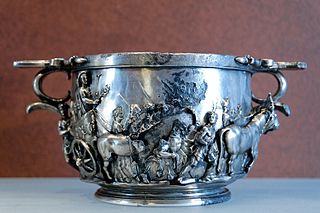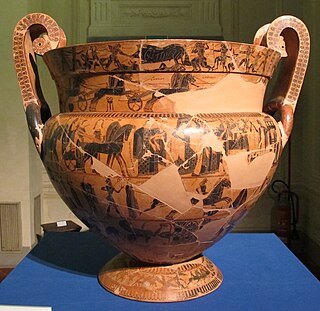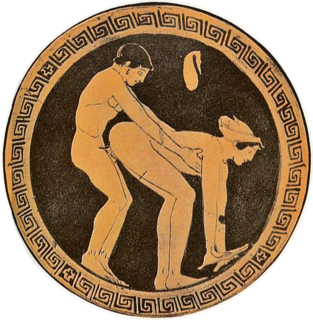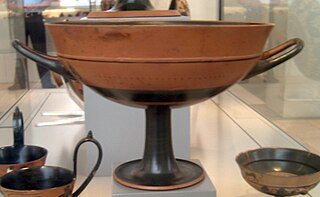
Black-figure pottery painting, also known as the black-figure style or black-figure ceramic is one of the styles of painting on antique Greek vases. It was especially common between the 7th and 5th centuries BC, although there are specimens dating as late as the 2nd century BC. Stylistically it can be distinguished from the preceding orientalizing period and the subsequent red-figure pottery style.

A skyphos is a two-handled deep wine-cup on a low flanged base or none. The handles may be horizontal ear-shaped thumbholds that project from the rim, or they may be loop handles at the rim or that stand away from the lower part of the body. Skyphoi of the type called glaux (owl) have one horizontal and one vertical thumbhold handle.

The Amasis Painter was an ancient Greek vase painter who worked in the black-figure technique. He owes his name to the signature of the potter Amasis, who signed 12 works painted by the same hand. At the time of the exhibition, "The Amasis Painter and His World" (1985), 132 vases had been attributed to this artist.

The pottery of ancient Greece has a long history and the form of Greek vase shapes has had a continuous evolution from Minoan pottery down to the Hellenistic era. As Gisela Richter puts it, the forms of these vases find their "happiest expression" in the 5th and 6th centuries BC, yet it has been possible to date vases thanks to the variation in a form’s shape over time, a fact particularly useful when dating unpainted or plain black-gloss ware.

Ergotimos (Έργότιμος) was a Greek potter, active in Athens, circa 570–560 BC. His son Eucharios was also a potter, as was a grandson whose name is not known.
The following works signed by him are known:

The Triptolemos Painter was an ancient Greek vase painter, belonging to the Attic red-figure style. He was active in Athens between 490 and 470 BC. His real name is not known. He started working in the workshop of Euphronios, where he was probably taught by Douris. Later, he also worked for the potters Brygos, Hieron and Python. Initially, his style was strongly influenced by Archaic art. His later works are mediocre in quality. Nonetheless, his repertoire is broad, reaching from the Apaturia procession via erotic scenes and Theban scenes to the departure of Triptolemos.

Wedding Painter is the conventional name for an ancient Greek vase painter active in Athens from circa 480 to 460 BC. He painted in the red-figure technique. His name vase is a pyxis in the Louvre depicting the wedding of Thetis and Peleus.
Hermogenes is a Greek name (Ἑρμογένης), meaning "born of Hermes". It may refer to:

The Painter of Berlin A 34 was a vase painter during the pioneering period of Attic black-figure vase painting. His real name is unknown, his conventional name derived from his name vase in the Antikensamlung Berlin. He is the first individual vase painter of the style in Athens recognised by scholarship. His works are dated to circa 630 BC. Two of his vases were discovered in Aegina. Since the 19th century, those pieces were on display in Berlin, but they disappeared or were destroyed during the Second World War.
The Comast Group was a group of Attic vase painters in the black-figure style. The works of its members are dated to between 585 and 570/560 BC.
The artists of the Komast Group are seen as the successors of the Gorgon Painter. Its most important representatives were the KX Painter and the slightly later KY Painter. They painted vases shapes that had been newly introduced to Athens or that had not previously been painted. Especially commonly painted by them were '’kothon’’ and lekanis. From Corinth, then still the centre of Greek vase painting, they adopted the Komast cup and the skyphos (known as kotyle. The KY Painter introduced the column krater. Also popular at the time was the kantharos. The group adopted the Corinthian habit of depicting komasts, after which the group is named. It provided the group’s most commonly painted motif. The komast scenes permit Attic artists for the first time to reach the artistic levels of middle-ranking Corinthian vases. While the older KX Painter still mostly painted animals and only the occasional komast scene, the komos became a standard motif for the KY painter and further inferior successors. It is not clear to what extent the painters of the group really cooperated. It is possible that they all worked in the same workshop. The group influenced later Attic vase painters, including the Heidelberg Painter.
Works by the Komast Group were not only found in Attica, but appear to have been exported widely. Vases and fragments have been found at many sites, including Naukratis, Rhodes, Central Italy, Taras, and even Corinth.

The Polos Painter was a vase painter of the Attic black-figure style. His works date to c. 575 to 565 BC.

The C Painter was one of the most important Attic black-figure vase painters. His works date to circa 575–550 BC.
His conventional name was allocated by the archaeologist John Beazley. The C stands for "Corinthianising", a reference to the strong influence of Corinthian vase painting on the artist. He was successor to the Comast Group and used the relatively old-fashioned range of vessel shapes preferred by that group, including '’lekanis’’, tripod kothon and skyphos. In contrast, he also painted quite innovative lekythoi with pronounced shoulders, although the more conservative Deinaeira type was still in use by some workshops at his time. The C Painter was the first Attic vase painter to paint cups without an offset lip, the Merrythought cup.

Little-master cups are a type of Attic black-figure cups, produced around the middle and third quarter of the sixth century BC. Their name is based on their fine small-format decoration.
Little-master cups are later in origin than Siana cups, but both types were produced over a considerable period of time. The Little masters painted only the small upper frieze above the carination of the cup, at times also the lip or handle areas. It is probably that only few of the painters of Siana cups also painted Little-master cups. One of the first artists to introduce the Little-master cup in Athens was Kleitias. The change in decoration went along with a lengthening of the cup foot. The dedicated painters of Little-master cups rarely painted larger formas, whereas painters primarily specialised in large vases are known to also have painted Little-master cups. Stylistic comparison between larger and smaller formats of the period remains difficult.

Band cups are a form of ancient Greek Attic Little-master cups.
The lip of a band cup is black and slightly concave. At the joint between vase body and foot, there is often a red ring. The external figural decoration is in the area of the handles, often framed by palmettes. Internal images and inscriptions are quite rare. Some specimens are completely black with the exception of some figures near the handles. Another very rare group of specimens, attributed to the potter Andokides and his workshop, have figural decoration on the flat base of the foot.
It remains unknown why band cups and Lip cups existed side by side for a considerable period. Perhaps, each variant had its own distinctive advantages. For example, it may have been more pleasant to drink from the undecorated black-slipped lip of a band cup, while the strong ridge underneath the rim of lip cups would have prevented spilling more effectively. Lip cups were somewhat more difficult to produce.
Well-known artists of this type were Hermogenes, Glaukytes, the Centaur Painter, Neandros, Sokles and the Oakeshott Painter.

Lip cups are a type of ancient Greek Attic Little-master cups.
Lip cups were produced from the middle of the sixth century BC in Athens. They resemble Gordion cups, but their lips or rims were more clearly distinguished from the rest of the body. They had high feet on broad bases. Early specimens in particular feature hollow conical feet with walls of even thickness.
Phrynos was a Greek potter, active in Athens, circa 560-545 BC. He is one of the Little masters. Three signed Lip cups by him are known:

Band skyphoi are a specific form of ancient Attic vase. They are a hybrid between conventional skyphos and band cup. The shape of the skyphos is combined with decorative scheme of band cups.
In terms of their shape, band skyphoi are somewhat squatter than the skyphoi of the Komast Group. As on band cups, their lips are concave. They tend to be of lower quality than cups. The fact that not a single band skyphos has so far been found to be signed indicates that the producers were aware of that difference. There are a number of further related shapes: for example, the Hermogenic skyphos, produced in a similar fashion to Komast Group skyphoi, but with very fine thin walls and slightly flayed lips. The Amasis Painter added a red stripe each on the exterior and interior surface to the conventional decoration.

The Phrynos Painter was an Attic black-figure vase painter, active in Athens between c. 560 and 545 BC.
He was allocated the conventional name Phrynos Painter after the potter Phrynos, as he had painted three cups signed by the latter:
The BMN Painter was an Attic vase painter in the black-figure style, active during the third quarter of the 6th century BC.




















